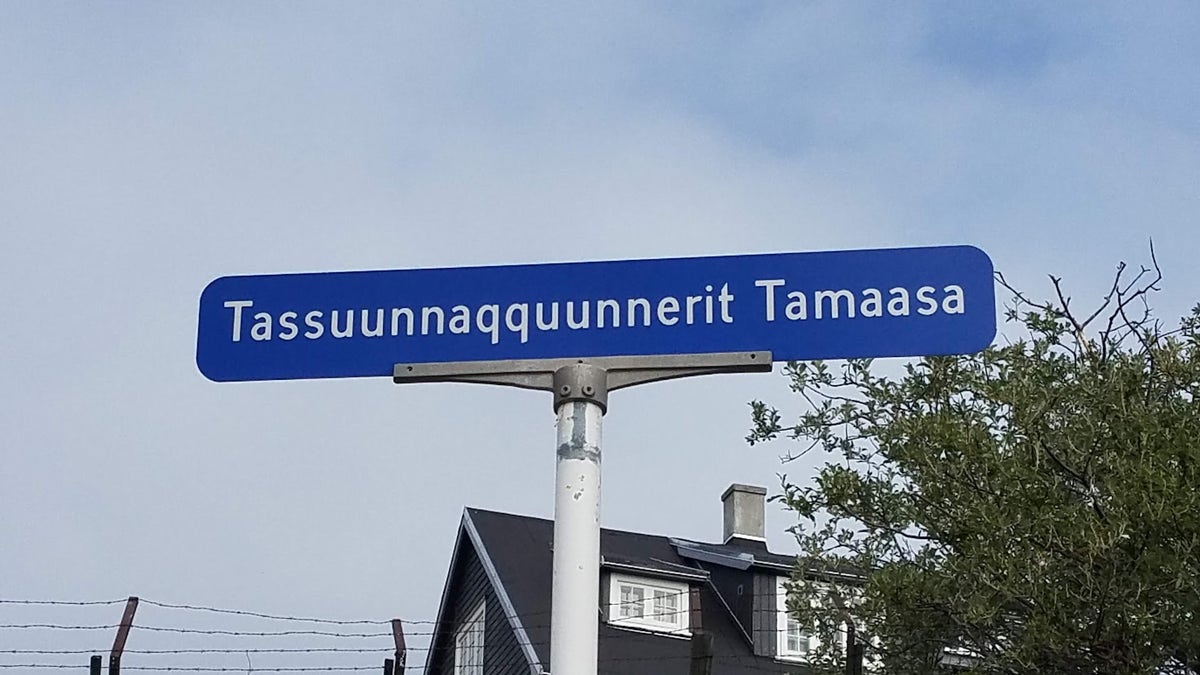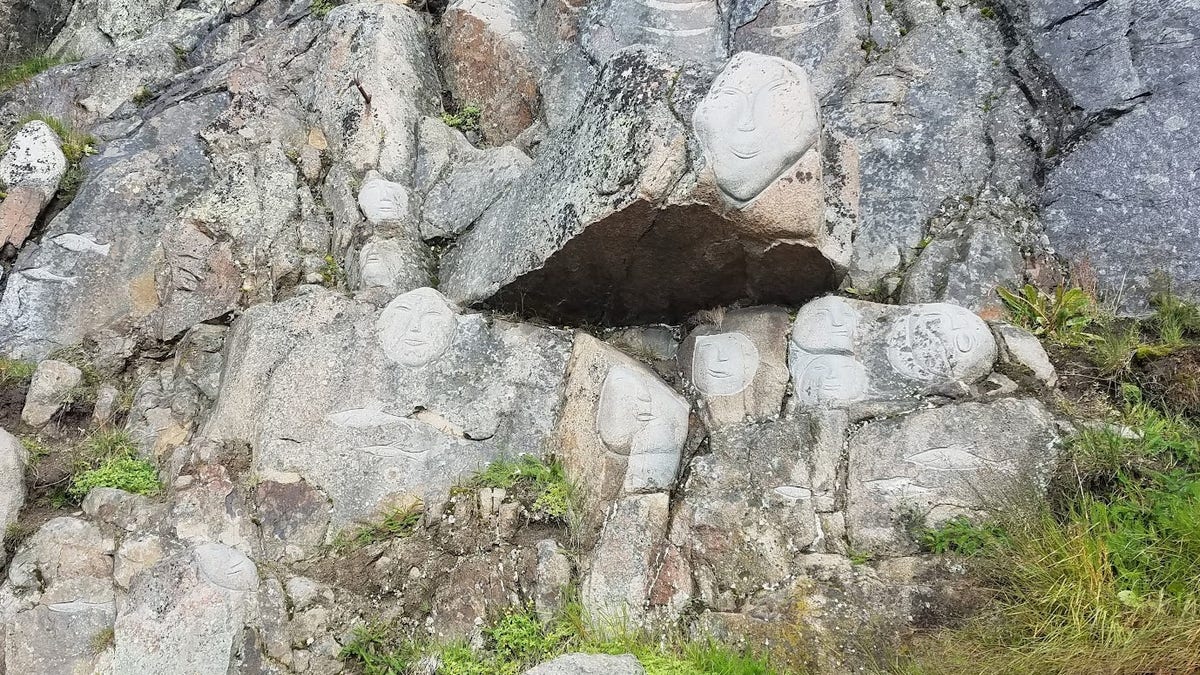World
‘Gone too soon’: Fans gather in Ireland to bid farewell to Sinead O’Connor

Large crowds of people have lined a coastal road in Ireland to pay their respects to Sinead O’Connor, the gifted singer and lifelong activist who died last week.
Fans on Tuesday left handwritten notes and flowers outside O’Connor’s former home in Bray, County Wicklow, thanking her for sharing her voice and her music. One sign listed causes that the superstar singer, who converted to Islam in 2018, had expressed support for, including welcoming refugees.
“Thanks for your short special life,” one note read. “Gone too soon.”
“She was so rebellious and empowering and inspiring, and my mother hated me listening to her music,” said Ruth O’Shea, who had come to Bray, south of the capital, Dublin, with her two daughters.
“She was just brilliant. Brilliant – I loved her, and then the kids, I suppose by osmosis because I played her when they were both growing up, they’d go, ‘Oh God, mum’s listening to Sinead O’Connor, she’s obviously had a rough day.’ She just gave me hope. And I just loved her, I loved her.”
O’Connor, 56, was found unresponsive at her London home on July 26. Police have not shared a cause of death, though they said her death was not suspicious.
O’Connor’s family invited the public to line the waterfront as her funeral procession passed by, following a private service.
“Sinead loved living in Bray and the people in it,” her family said in a statement. “With this procession, her family would like to acknowledge the outpouring of love for her from the people of Wicklow (county) and beyond, since she left … to go to another place.”
O’Connor, a multi-octave mezzo-soprano of extraordinary emotional range who was recognisable by her shaved head, began her career singing on the streets of Dublin and soon rose to international fame.
She became a sensation in 1990 with her cover of Prince’s ballad Nothing Compares 2 U, which topped charts from Europe to Australia.
The song received three Grammy nominations and was the featured track on her acclaimed album, I Do Not Want What I Haven’t Got, which helped lead Rolling Stone to name her Artist of the Year in 1991.
O’Connor’s other musical credits included the albums, Universal Mother and Faith and Courage, a cover of Cole Porter’s You Do Something to Me, from the AIDS fundraising album Red Hot + Blue, and backing vocals on Peter Gabriel’s Blood of Eden. She received eight Grammy nominations and in 1991 won for best alternative musical performance.
After converting to Islam, she took on the Muslim name Shuhada’ Davitt – later changing it to Shuhada Sadaqat – but continued to use the name Sinead O’Connor professionally.
A lifelong nonconformist, she said she shaved her head in response to record executives pressuring her to be conventionally glamorous.
She was a critic of the Roman Catholic Church well before allegations of sexual abuse were widely reported. She made headlines in October 1992 when she tore up a photo of Pope John Paul II while appearing on NBC’s Saturday Night Live and denounced the church as the enemy.
She was public about her struggles with mental illness. When her teenage son Shane died by suicide last year, O’Connor tweeted there was “no point living without him” and she was soon hospitalised. Her final tweet, sent July 17, read “For all mothers of Suicided children,” and linked to a Tibetan compassion mantra.
Since her death, celebrities have paid tribute to her, and people have shared acts of kindness she performed.


World
Trump's family circle has a different look as he returns to the White House
WASHINGTON (AP) — When Donald Trump returns to the White House on Monday, his family circle will look a little different than it did when he first arrived eight years ago.
His youngest son, Barron, was in fifth grade back then. He’s now a college freshman who towers over his 6-foot-plus (1.8-meter-plus) dad. Granddaughter Kai, who was 9 in 2017, is now an aspiring social media influencer and impressive golfer. Grandson Joseph, who posed in Trump’s lap with a Lego model of the White House last time, is 11 now.
The most prominent relatives in Trump’s political sphere, daughter Ivanka and her husband, Jared, are in Florida this time around after working in his first administration.
Family members can provide presidents with a ready source of moral and sounding-board support, companionship and even relief from the world’s problems. Not to mention creating headaches for the president at times, too.
“Family can do things that other people can’t, and they can be trusted in a way that other people also can’t,” said Tevi Troy, a former George W. Bush administration official and author of several books about the presidency. “Everyone needs someone they can talk to late at night when you let your hair down, so to speak.”
The president-elect has five children — three of whom are married — from his marriages to Ivana Trump, Marla Maples and current wife Melania Trump. He has 10 grandkids, with an 11th on the way.
A look at Trump’s family circle, then and now:
Former first lady Melania Trump speaks at a campaign rally, Oct. 27, 2024, in New York. (AP Photo/Julia Demaree Nikhinson, File)
His wife:
THEN: She spent the opening months of Trump’s term at the family’s Manhattan penthouse so that 11-year-old Barron wouldn’t have to switch schools in the middle of the year. After moving to the White House, she traveled around the United States and to other countries, alone and with Trump, partly to promote her “Be Best” children’s initiative while fiercely guarding her privacy.
NOW: She avoided active campaigning during Trump’s 2024 run, limiting her public appearances to key moments, such as the campaign’s launch, the Republican National Convention and election night. She released a self-titled memoir late last year and will be the subject of a documentary distributed by Amazon Prime Video that is expected to be released later this year. While some doubt that Trump’s 54-year-old wife will spend much time at the White House, she said on Fox News’ “Fox & Friends” that she has already packed and picked out the furniture she wants to take to the executive mansion.
Donald Trump Jr. attends a rally for his father, Republican presidential nominee former President Donald Trump, at Madison Square Garden, Oct. 27, 2024, in New York. (AP Photo/Julia Demaree Nikhinson, File)
THEN: Trump’s eldest son, now 46, campaigned for his father in 2016 and 2020.
NOW: Trump Jr.’s influence has grown to the point that he lobbied his father to choose close friend JD Vance for vice president. He also pushed for former Democratic Rep. Tulsi Gabbard and Robert F. Kennedy Jr., the president-elect’s picks for director of national intelligence and health and human services, respectively. Trump Jr. helps run the family real estate business and is an honorary chairman of Trump’s transition. He has a podcast and has said his role is to prevent “bad actors” from getting into the administration. He recently flew on his father’s airplane to Greenland; the president-elect has expressed a desire to take control of the mineral-rich Danish territory.
Trump Jr. has five children — or “smurfs,” as he sometimes refers to them — with his former wife, Vanessa Trump. They are Kai Madison, 17; Donald John III, 15; Tristan Milos, 13; Spencer Frederick, 12; and Chloe Sophia Trump, 10.
Ivanka Trump exits the courtroom for a lunch break during a civil fraud trial against her father, former President Donald Trump, at New York Supreme Court, Nov. 8, 2023, in New York. (AP Photo/Yuki Iwamura, File)
THEN: Ivanka, 43, campaigned for her father in 2016 and moved her family from New York City to Washington to work in his White House as a senior adviser. She was on the campaign trail in 2020, too, but she and her family moved to Florida and retreated from the spotlight after his loss.
NOW: As Trump geared up for the 2024 run, Ivanka announced that she loved and supported him but was getting out of politics to focus on her husband and their three kids. She did, however, join her father and other family members on election night and when he rang the bell at the New York Stock Exchange in early December after Time magazine named him Person of the Year. She told “The Skinny Confidential” podcast that this time around she just wanted to “show up for him as a daughter” and be there to watch a movie or a sports game.
Ivanka and her husband have three children: Arabella Rose, 13; Joseph Frederick, 11; and Theodore James Kushner, 8.
Eric Trump appears in the spin room after a presidential debate, Sept. 10, 2024, in Philadelphia. (AP Photo/Matt Slocum, File)
THEN: The 40-year-old helped run the family business and participated in his father’s campaigns.
NOW: Eric is also an honorary chair of the transition and a close adviser to his father. But he continues to focus more on running the family business. In September, he and his brother started a crypto platform called World Liberty Financial, and their father helped launch it in an interview on the X social media platform.”
Eric and his wife, Lara, have two children: Eric Luke, 7, and Carolina Dorothy Trump, 5.
Tiffany Trump and her husband, Michael Boulos, listen as Republican presidential nominee former President Donald Trump speaks at a campaign rally at Williams Arena at Mignes Coliseum, Oct. 21, 2024, in Greenville, N.C. (AP Photo/Julia Demaree Nikhinson, File)
THEN: Trump’s daughter with second wife Marla Maples was 23 and a recent University of Pennsylvania graduate who kept a low profile when Trump was first elected.
NOW: She was more present in the 2024 campaign but still largely avoids the spotlight. Tiffany, 31, and her husband, Michael Boulos, are expecting their first child this year. Boulos is a businessman who traveled with Trump in the final stretch of the campaign. His father is Massad Boulos, a Lebanese American businessman who helped Trump with the influential Arab American community in the swing state of Michigan. Trump has named Massad Boulos to be a senior adviser on Arab and Middle Eastern affairs.
Barron Trump stands on the South Lawn of the White House on the fourth day of the Republican National Convention in Washington, Aug. 27, 2020. (AP Photo/Evan Vucci, File)
THEN: At the start of Trump’s first term, Barron and his mother stayed at the family’s Trump Tower penthouse in Manhattan so he could finish his school year. When they got to Washington, his soccer net appeared in what’s known as the first lady’s garden.
NOW: Barron, 18, is a freshman New York University business student. His parents and Trump campaign officials credit him for recommending podcasts popular with young men that the president-elect appeared on during the campaign. Barron will have a bedroom in the White House, Melania Trump said on “Fox & Friends.”
“I’m very proud of him, about his knowledge, even about politics and giving an advice to his father,” his mother said on the program. “He brought in so many young people. He knows his generation.”
Republican National Committee Co-Chair Lara Trump walks onstage at a campaign event for Republican vice presidential nominee Sen. JD Vance, R-Ohio, in Monroe, N.C., Oct. 25, 2024. (AP Photo/Nell Redmond, File)
Other family members in the spotlight:Lara Trump
THEN: Trump’s daughter-in-law, 42, campaigned for him during all his runs. After Trump lost to Democrat Joe Biden in 2020, she considered running for a U.S. Senate seat from her home state of North Carolina but ultimately decided against it. She became a Fox News commentator.
NOW: As Trump revved up his 2024 campaign, he installed his daughter-in-law as co-chair of the Republican National Committee, where she was a TV-ready advocate overseeing fundraising, voter outreach and the party’s “election integrity” initiative. She stepped down from the RNC after the election and removed her name from consideration as a possible successor to Sen. Marco Rubio, R-Fla., Trump’s choice for secretary of state.
Lara Trump is passionate about fitness and has her own line of activewear. She also has explored a side venture as a singer and has released some songs. Daughter Carolina is named after her home state.
Ivanka Trump and Jared Kushner are seen during the final day of the Republican National Convention, July 18, 2024, in Milwaukee. (AP Photo/Paul Sancya, File)
THEN: Kushner, 44, was also a key figure in Trump’s 2016 campaign. He joined his wife in the White House as a senior adviser, a role that included working on U.S. policy toward Israel and the broader Middle East.
NOW: Kushner has stepped out of the political spotlight — but his father could soon step in. Trump announced after the election that he intends to nominate Charles Kushner, a real estate developer, to be U.S. ambassador to France. The elder Kushner was pardoned by Trump in December 2020 after he pleaded guilty years earlier to tax evasion and making illegal campaign contributions.
Kai Trump, granddaughter of former President Donald Trump, walks on the 18th green during the ProAm of the LIV Golf Team Championship at Trump National Doral Golf Club, Oct. 27, 2022, in Doral, Fla. (AP Photo/Lynne Sladky, File)
Kai Trump
THEN: Kai was in elementary school when her grandfather became president.
NOW: Donald Trump Jr.’s 17-year-old granddaughter is an aspiring social media influencer. Her behind-the-scenes video from election night garnered 3.7 million views on YouTube. Other posts related to her grandfather have been watched millions more times on TikTok. Kai delivered her first public speech at the Republican convention and is an avid golfer who sometimes plays with her grandfather.
“If I’m not on his team, he’ll try to get inside of my head, and he’s always surprised that I don’t let him get to me,” she said at the convention. “But I have to remind him, I’m a Trump, too.”
Arabella Kushner
THEN: Ivanka Trump and Jared Kushner’s daughter was 6 when her grandfather showed China’s Xi Jinping a video of her, in a traditional Chinese dress, belting out Chinese-language songs.
“It’s very good, right? She’s very smart,” Trump said. Xi responded that Arabella was her grandfather’s “little angel” and a “messenger of China-U.S. relations.”
NOW: Arabella is 13 and enjoys singing, playing the piano, horseback riding and Brazilian jiu-jitsu, according to a social media post from her mother.
___
Gomez Licon reported from West Palm Beach, Florida.
World
Exploring Greenland's majestic history as President-elect Trump shines spotlight on island nation

Before President-elect Trump took a shine to it, Greenland was already on the radar of the cruise ship industry with many vessels choosing picturesque Greenlandic towns for their ports of call.
Cruise ship passengers take photos of fjords in Greenland (Danuta Hamlin)
One of the ports is Qaqortoq, the largest town in southern Greenland.

Qaqortoq means “white” in the Greenlandic language. (Danuta Hamlin)
Sailing from Iceland, the ship followed in the footsteps of Eric the Red, a Norseman who settled this area in 982. As Eric was exiled from Iceland, he made his home here and called it Greenland.
Some 80% of the island is covered by icecap and the remaining parts do not appear very green either.
‘MAKE GREENLAND GREAT AGAIN’: TRUMP’S HOUSE GOP ALLIES UNVEIL BILL TO AUTHORIZE COUNTRY’S PURCHASE

Majestic shores of Greenland (Danuta Hamlin)
According to some historians, Eric the Red came up with the name simply for promotional purposes.
He set out to attract more settlers from Iceland and advertised the island as a green land. Some experts say that Greenland could have been warmer at the time, but starting in the 15th century it experienced what is known as “The Little Ice Age.”

Children in Nanortalik, Greenland. (Danuta Hamlin)
Life in Greenland became too harsh for Europeans. But the native population of the Island found ways to persevere.

Julianehåb River runs through the center of Qaqortoq, Greenland. (Danuta Hamlin)
Nestled in the midst of a scenic fjord system, with a creek cascading across the town, and snow capping the mountain peaks even in the spring, Qaqortoq is a fascinating place to explore.
RUSSIA MONITORING TRUMP’S ‘DRAMATIC’ COMMENTS ON GREENLAND ACQUISITION

Qaqortoq is the fourth-largest town in Greenland. (Danuta Hamlin)
Building highways in Greenland is expensive, therefore Qaqortoq is not connected by road to any other town or village. However, when the weather is warmer, the region provides ample opportunities for nature hikes, kayaking and fishing.

Qaqortoq Greenland (Danuta Hamlin)
The town was founded in 1775, as a trade colony, by Norwegian explorer Anders Olsen. With a population of just a little over 3,000, it offers a glimpse of Greenlandic life, Viking history and Nordic-inspired architecture.
The hills are peppered with colorful houses, creating a delightful contrast with the severe peaks of the surrounding fjords.

A street sign in Greenland. Greenlandic is an Eskimo–Aleut language with about 57,000 speakers. (Danuta Hamlin)
Greenland is an autonomous territory of the Kingdom of Denmark, but the official language is Greenlandic. It’s a polysynthetic language which means that, technically, there is no limit to the length of a Greenlandic word.
Deciphering local signs can be fun and challenging at the same time.

Stone & Man, an open-air art project in Qaqortoq, Greenland, featuring rock carvings and sculptures (Danuta Hamlin)
TRUMP ESCALATES PLANS TO ACQUIRE GREENLAND AFTER RESIDENT PLEADS: ‘DENMARK’S USING US’
Although trees are not easy to find, the area is full of all kinds of rocks and boulders. Some of them were turned into carvings of faces and whales, in a tribute called “Stone & Man.” This open-air gallery is the work of local Qaqortoq artist Aka Høegh.

Mindebrønden fountain is the older of the only two public fountains in Greenland. (Danuta Hamlin)
Qaqortoq boasts the oldest fountain in the country – Mindebrønden – Memorial Fountain. The fountain was completed in 1932 and is turned off during the winter months.

A fish market in Qaqortoq. Seal meat is a key ingredient in Greenland’s national dish, Suaasat. (Danuta Hamlin)
The town’s fish market sells whatever has been caught on a given day by local fishermen. It could be fish, or it could be whale meat, or perhaps a seal.
Qaqortoq is, after all, a fisherman’s town and seafood plays a vital part in Greenland’s diet.

Nanortalik is a village on Nanortalik Island, with some 1,072 inhabitants. (Danuta Hamlin)
The official religion of Greenland is Evangelical Lutheranism. In another port of call, a village called Nanortalik, members of the local congregation welcomed tourists with a musical performance.

Nanortalik choir singing outdoors in Greenland in 2018. (Danuta Hamlin)
CLICK TO GET THE FOX NEWS APP
Nanortalik means the “Place of Polar Bears”. No bears, however, were spotted loitering around the village.

Nanortalik’s old colonial port area is an open-air museum. (Danuta Hamlin)
Greenland is the world’s largest island – a treat for any tourist adventuresome enough to venture there.

Cruise ship passengers take photos of fjords in Greenland (Danuta Hamlin)
The author recently took a cruise to Greenland.
World
Brussels, my love? NATO's warning: we're not at war, and not at peace

In this edition, we hear how Austria is on the cusp of crowning a far-right leader, and examine NATO chief Mark Rutte’s plans to mend relations with the EU.
Our guests this week include Austrian socialist MEP Andreas Schieder, Marta Mucznik, EU senior analyst with the International Crisis Group and Riho Terras, Estonian MEP with the European People’s Party.
The panel reflect on the first visit this week by NATO’s new Secretary General to the European Parliament.
Mark Rutte, who was Dutch Prime Minister for years, is courting EU institutions and political parties as he seeks to improve relations and boost defence investment. Riho Terras, a former army general, applauds his ambition.
“If Putin wins in Ukraine, then we will have 40 million angry Ukrainians against us and pretty soon we will face the same threat”, said Terras, adding that Kyiv is as close to Berlin as it is to Tallinn.
The panel also took a deep dive into Austrian politics, which, five months after elections, are in a mess. After Karl Nehammer resigned earlier this month, far-right firebrand Herbert Kickl, known for his anti-EU, anti-NATO, xenophobic views, looks set to become chancellor, with his party dominating a coalition with the centre-right Austrian People’s Party (ÖVP).
Andreas Schieder, who was involved in the initial coalition negotiations, blamed ÖVP for cosying up to the far right, and that the truth about the dire state of Austrian finances only came out after the elections.
“Conservatives always say the others are guilty, that we have now to accept the extreme right”, Schieder said.
Finally, the panel discussed media trends for 2025 and the dwindling trust in mainstream news sources.
Marta Mucznik said she could never replace her TV or newspaper.
“Social media will never replace traditional, conventional media … It provides no context, it proliferates fake news,” she said. “It’s propaganda, it’s not information.”
Watch ‘Brussels, my love?’ in the player above.
-
/cdn.vox-cdn.com/uploads/chorus_asset/file/25822586/STK169_ZUCKERBERG_MAGA_STKS491_CVIRGINIA_A.jpg)
/cdn.vox-cdn.com/uploads/chorus_asset/file/25822586/STK169_ZUCKERBERG_MAGA_STKS491_CVIRGINIA_A.jpg) Technology1 week ago
Technology1 week agoMeta is highlighting a splintering global approach to online speech
-

 Science7 days ago
Science7 days agoMetro will offer free rides in L.A. through Sunday due to fires
-
/cdn.vox-cdn.com/uploads/chorus_asset/file/23935558/acastro_STK103__01.jpg)
/cdn.vox-cdn.com/uploads/chorus_asset/file/23935558/acastro_STK103__01.jpg) Technology7 days ago
Technology7 days agoAmazon Prime will shut down its clothing try-on program
-

 News1 week ago
News1 week agoMapping the Damage From the Palisades Fire
-

 News1 week ago
News1 week agoMourners Defy Subfreezing Temperatures to Honor Jimmy Carter at the Capitol
-
/cdn.vox-cdn.com/uploads/chorus_asset/file/25826211/lorealcellbioprint.jpg)
/cdn.vox-cdn.com/uploads/chorus_asset/file/25826211/lorealcellbioprint.jpg) Technology6 days ago
Technology6 days agoL’Oréal’s new skincare gadget told me I should try retinol
-
/cdn.vox-cdn.com/uploads/chorus_asset/file/25832751/2192581677.jpg)
/cdn.vox-cdn.com/uploads/chorus_asset/file/25832751/2192581677.jpg) Technology3 days ago
Technology3 days agoSuper Bowl LIX will stream for free on Tubi
-

 Business4 days ago
Business4 days agoWhy TikTok Users Are Downloading ‘Red Note,’ the Chinese App

















